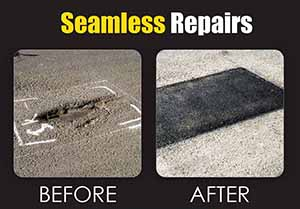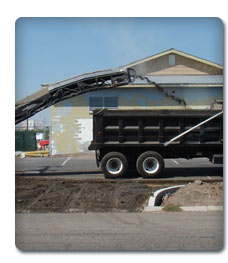Asphalt Repairs
Seamless Asphalt Repair (New!)
The Seamless Asphalt Repair uses infrared technology to reheat existing asphalt to a malleable state so that it can be reworked and reused. During the process, the reheated asphalt is loosened up, new asphalt and rejuvenating oils are added to replace what has been lost in the aging process, and then finish raked and compacted to yield a brand new surface. It only takes up to 30 minutes to give you a permanent repair. The best part is that these small repairs are very inexpensive!
Removal and Replacement of Existing Asphalt (R&R)
The deterioration of asphalt occurring as a result of lack of maintenance, overuse, or simply living past its life expectancy. In such cases, old asphalt pavement may need to be removed and replaced or refurbished with one of the following options:
- Pothole Repair
- Skin Patching
- Overlay
- Fabric Overlay
- Asphalt Grinder (Milling Machine)
- Complete Removal & Replace
- Over Excavation (OX)
Pothole Repair
Potholes occur when moisture penetrates cracks in the asphalt surface of a road or driveway. Cold weather freezes the water and causes it to expand. A pothole forms when dirt and gravel is forced out leaving a hole. The ice eventually melts and the stressed asphalt becomes a pothole. Asphalt Protectors will cut out the pothole area, clean it and use an asphalt filling appropriate for the repaired area.
Back To Top
Skin Patching
Skin patch patches are used to fill depressions, in which case the patch could be as thick as three or four inches. A skin patch differs from removal and replacement because existing asphalt is not removed during skin patching. This type of repair should only be used when there is no base failure, to correct drainage. Skin Patch is also used to isolate asphalt that is Spaulding (loose & rough) to extend the life of the asphalt (3-10 Yrs.).Skin patches generally use a fine sand aggregate as opposed to coarse aggregate because the edges of the patch are “feathered” out to zero thickness. Usually skin patching is used to improve the appearance of pavement or stop water penetration. Skin patches are generally 1 ½ inches or less in thickness.
Overlay
When an asphalt pavement surface deteriorates to the point of needing repair, an asphalt overlay is an effective solution. A standard asphalt overlay consists of a new layer of asphalt applied over the existing asphalt surface. The thickness of an overlay should range 1 ½ to 2 inches, but type and amount of traffic as well as individual customer’s needs are also considered. The existing asphalt surface may be milled if grades need to be maintained or altered. Milling is a process by which a machine is used to plane the pavement surface to an appropriate depth before it is covered with the new layer. Once the milling is finished and the overlay is completed, the customer is left with a brand new surface, ready for pavement marking.
Fabric Overlay
When a pavement surface begins to develop widespread surface cracking due to subgrade failure, an asphalt fabric overlay is a reliable alternative to costly excavation and replacement of the cracked and deteriorated asphalt.
Most subgrade failures arise from surface water seeping down into the pavement’s aggregate base course and weakening the foundation soil’s shear strength. Once this occurs, it is not long before surface cracking appears due to the weight placed on the pavement over this weak foundation. Simply placing a layer of slurry seal over these cracks will only provide a very temporary solution, as reflective cracking will soon take place.
Reflective cracking is a situation in which the cracks covered by new layers of slurry or asphalt make their way back up to the surface. Although it is bound to happen, the reflective cracking takes much longer if an asphalt fabric overlay is utilized rather than a simple slurry seal. The geo textile fabric will create a moisture barrier that will prevent water from passing through cracks, joints, and the porous pavement itself, keeping the aggregate base course and foundation soil intact and strong. It will also absorb much of the energy normally transferred from cracks in the old pavement into the new asphalt overlay by its sheer resistance and ductility. These functions are paramount in preventing reflective cracking as well as surface deflections and potholes.
The asphalt fabric overlay is begun by cleaning the existing surface of dust, dirt, vegetation, and moisture. In some instances large cracks are filled to improve the performance of the fabric by supporting it underneath. A layer of AC 20=SS-1h solution, a hot, viscous liquid asphalt, is applied at a fairly heavy volume of .2 gallons per square yard. Then, while the AC 20=SS-1h is still hot, the geo textile fabric is rolled on to the surface within one foot of the perimeter. Wrinkles are smoothed out and then it is ready to be paved over. A minimum of 1.5 inches of asphalt is applied and compacted. During the paving process, the AC 20 melts from the heat of the new asphalt, and the compaction forces cause the AC 20 to soak through the fabric. This creates a waterproof membrane that effectively adheres to both the new and old asphalt pavements.
Long-term field evaluations have shown that the proper use of paving fabrics in asphalt overlays can increase pavement life up to 50%. Utilizing asphalt fabric overlays will reduce maintenance costs and improve the effectiveness of your pavement management system without the need to reconstruct.
Asphalt Grinder (Milling)
Utilizing a milling machine, the deteriorated asphalt is recycled by grinding it into small bits. This material is then graded and re-compacted for use as part of the base for the new pavement. This method is environmentally sound and is used whenever possible. Drainage and grade considerations help determine if this approach is a valid option.
Back To Top
Complete Removal and Replacement
Severe subgrade deficiencies may require complete removal of part or all of the pavement and base material. After excavation and removal, pre-existing conditions in the subgrade such as excess moisture, shallow utility lines, missing aggregate base, or incorrectly prepared subgrade may require additional steps in the base preparation. These conditions are usually not discovered until the overlying asphalt is removed. After careful inspection, your Ace Asphalt representative can recommend the most effective methods to resolve these conditions. When pre-existing conditions have been corrected, new aggregate is supplied as needed and re-compacted. The new asphalt is then placed and compacted with vibratory rollers to finish the process.
Over Excavation (OX)
Applies when the remove and replace of asphalt occurs. Once the asphalt is removed and the base is being graded, the heavy equipment or even walking will create a pumping action in the base. If the base fluctuates, these areas must be OX’d. Depending on the material make-up, over excavation can be up to two feet below the base grade. Once the unsuitable material is removed, base material is installed in increments of three-inch layers and compacted until grade is achieved.

